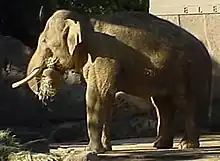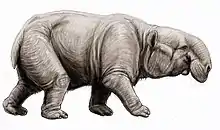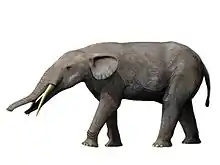Elephas
Elephas is one of two surviving genera in the family of elephants, Elephantidae, with one surviving species, the Asian elephant, Elephas maximus.[1]
| Elephas Temporal range: Pliocene to present | |
|---|---|
 | |
| Asian elephant | |
| Scientific classification | |
| Domain: | Eukaryota |
| Kingdom: | Animalia |
| Phylum: | Chordata |
| Class: | Mammalia |
| Order: | Proboscidea |
| Family: | Elephantidae |
| Tribe: | Elephantini |
| Genus: | Elephas Linnaeus, 1758 |
| Type species | |
| Elephas maximus | |
| Species | |
|
8; see text | |
| Synonyms | |
|
Hypselephas | |
Several extinct species have been identified as belonging to the genus, extending back to the Pliocene era, with the earliest remains of the genus being from Africa, around 5-4.2 million years ago,[2] with the earliest records of the genus in Asia dating to around 3.6-3.2 million years ago.[3] While formerly assigned to this genus, Elephas recki, the straight-tusked elephant E. antiquus and the dwarf elephants E. falconeri and E. cypriotes are now placed in the separate genus Palaeoloxodon. The genus is very closely related to the genus Mammuthus.[4]
Taxonomy
The scientific name Elephas was proposed by Carl Linnaeus in 1758 who described the genus and an elephant from Ceylon.[5] The genus is assigned to the proboscidean family Elephantidae and is made up of one living and seven extinct species:[6]
- Elephas maximus – Asian elephant[1]
- Elephas maximus indicus – Indian elephant
- Elephas maximus maximus – Sri Lankan elephant
- Elephas maximus sumatranus – Sumatran elephant
- Elephas maximus borneensis – Borneo elephant, proposed but not yet recognized as valid[7]
The following Asian elephants were proposed as extinct subspecies, but are now considered synonymous with the Indian elephant:[1]
- Elephas maximus sondaicus – Javan elephant †
- Elephas maximus rubridens – Chinese elephant †
- Elephas maximus asurus – Syrian elephant †
The following Elephas species are extinct:
- Elephas beyeri – described from fossil remains found in 1911 in Luzon, the Philippines by von Königswald[8]
- Elephas celebensis – Sulawesi dwarf elephant, described from southern Sulawesi by Hooijer in 1949;[9] also known as Stegoloxodon celebensis
- Elephas ekorensis – described from the Kubi Algi Formation, Turkana, Kenya,[6] dating to the Early Pliocene, one of the oldest species of the genus.[2]
- Elephas hysudricus – described from fossil remains found in the Siwalik hills by Falconer and Cautley, 1845,[10] thought to be the ancestor of the living Asian elephant.[11]
- Elephas hysudrindicus – a fossil elephant of the Pleistocene of Java and different from Elephas maximus sondaicus[12]
- Elephas planifrons - one of the oldest species, known from the late Pliocene of the Indian subcontinent.[3]
- Elephas platycephalus
References
- Shoshani, J. (2005). "Genus Elephas". In Wilson, D.E.; Reeder, D.M (eds.). Mammal Species of the World: A Taxonomic and Geographic Reference (3rd ed.). Johns Hopkins University Press. p. 90. ISBN 978-0-8018-8221-0. OCLC 62265494.
- Sanders, William J.; Haile-Selassie, Yohannes (June 2012). "A New Assemblage of Mid-Pliocene Proboscideans from the Woranso-Mille Area, Afar Region, Ethiopia: Taxonomic, Evolutionary, and Paleoecological Considerations". Journal of Mammalian Evolution. 19 (2): 105–128. doi:10.1007/s10914-011-9181-y. ISSN 1064-7554. S2CID 254703858.
- Iannucci, Alessio; Sardella, Raffaele (28 February 2023). "What Does the "Elephant-Equus" Event Mean Today? Reflections on Mammal Dispersal Events around the Pliocene-Pleistocene Boundary and the Flexible Ambiguity of Biochronology". Quaternary. 6 (1): 16. doi:10.3390/quat6010016. hdl:11573/1680082. ISSN 2571-550X.
- Fleischer, R. C.; Perry, E. A.; Muralidharan, K.; Stevens, E. E. & Wemmer, C. M. (2001). "Phylogeography of the Asian Elephant (Elephas maximus) based on mitochondrial DNA". Evolution. 55 (9): 1882–1892. doi:10.1111/j.0014-3820.2001.tb00837.x. PMID 11681743.
- Linnaei, C. (1760). "Elephas maximus". Caroli Linnæi Systema naturæ per regna tria naturæ, secundum classes, ordines, genera, species, cum characteribus, differentiis, synonymis, locis. Vol. Tomus I. Halae Magdeburgicae: Ioannes Ioachimus Langius. p. 33.
- Maglio, V.J. (1973). "Origin and evolution of the Elephantidae". Transactions of the American Philosophical Society, Philadelphia Volume 63. American Philosophical Society, Philadelphia, pp. 149
- Fernando, P., Vidya, T.N.C., Payne, J., Stuewe, M., Davison, G., et al. (2003). DNA Analysis Indicates That Asian Elephants Are Native to Borneo and Are Therefore a High Priority for Conservation. PLoS Biol 1 (#1): e6
- Von Königswald, G.H.R. (1956). Fossil mammals from the Philippines. National Research Council of the Philippines, Manila
- Hooijer, D.A. (1949). Pleistocene Vertebrates from Celebes. IV. - Archidiskodon celebensis nov spec.. Zoologische Mededelingen Museum Leiden, 30 (#14): 205–226.
- Falconer, H. & Cautley, P. T. (1846). Fauna Antiqua Sivalensis, Being the Fossil Zoology of the Sewalik Hills. Smith, Elder & Company, London, pp. 64.
- Lister, Adrian M.; Dirks, Wendy; Assaf, Amnon; Chazan, Michael; Goldberg, Paul; Applbaum, Yaakov H.; Greenbaum, Nathalie; Horwitz, Liora Kolska (September 2013). "New fossil remains of Elephas from the southern Levant: Implications for the evolutionary history of the Asian elephant". Palaeogeography, Palaeoclimatology, Palaeoecology. 386: 119–130. Bibcode:2013PPP...386..119L. doi:10.1016/j.palaeo.2013.05.013.
- Hooijer, D. A. (1955). Fossil Proboscidea from the Malay Archipelago and the Punjab. Zoologische Verhandelingen, 28 (#1): 1–146.


